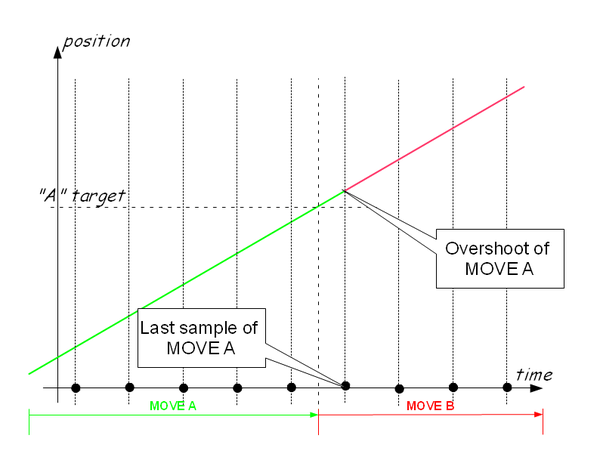Difference between revisions of "Concatenation of Movements/zh-hans"
(Created page with "{{Languages}} == 介绍 == Using ControlStudio, two motions can be "glued" together using a non-zero final velocity value. This method is called concatenation. It is a basic ...") |
(AXY: new links) |
||
| (4 intermediate revisions by 2 users not shown) | |||
| Line 1: | Line 1: | ||
| − | {{Languages}} | + | {{Languages|Concatenation_of_Movements}} |
| − | == | + | == 简介== |
| − | + | 使用ControlStudio,两个运动可以使用非零最终速度值"胶合"在一起。 这种方法称为连接。 这是一种基本的混合方式。 根据其插补规范,完全执行每个运动,而不是混合(CP,SP或AI),其中路径被修改以适应运动约束。 | |
| + | == 分配连接 == | ||
| + | 根据给定的运动元素是组/轴还是机器人,使用以下最终速度特性: | ||
| − | + | * '''Group/axis''': [[MC-Basic:element.VELOCITYFINAL|VFINAL]] (连同 [[MC-Basic:element.VELOCITYCRUISE|VCRUISE]]). | |
| + | * '''Robot''': [[MC-Basic:robot.VELOCITYFINALTRANS|VFTRAN]]和[[MC-Basic:robot.VELOCITYFINALROT|VFROT]] (连同[[MC-Basic:robot.VELOCITYTRANS|VTRAN]]和[[MC-Basic:robot.VELOCITYROT|VROT]]). | ||
| − | + | == 特殊问题 == | |
| − | + | === 曲线 === | |
| − | |||
| − | + | * 当指定最终速度时,重要的是注意实际的最终速度可以不同。 在给定的限制下,系统运动分析器尝试生成最佳(最快)的运动曲线。 实际最终速度将取决于运动的初始速度,运动长度和所有运动限制(例如,加速/减速最大,加加速度最大值)。 | |
| − | + | * 如果发出一连串的动作,最后一个以这样高的速度开始,运动不能在最后停止,则会发出'''自动制动'''错误。 | |
| − | * | + | * 如果最终速度太高,则可以达到最高可达到的最终速度。 |
| − | + | === 离散性 === | |
| − | + | 离散化是运动连接中发生的现象。 以非零最终速度结束的运动永远不会在最后一个运动样本处完成。 由于在每个系统样本中以指定的采样率完成运动曲线生成,因此最后一个样本将不会精确。换一种方式: | |
| − | |||
| − | |||
| − | |||
| − | |||
<math>v \cdot n \cdot T \neq L </math><br> | <math>v \cdot n \cdot T \neq L </math><br> | ||
| − | + | 过冲将作为新的初始位置转移到下一个运动。 在圆和线之间的过渡中,将考虑适当的投影因子 | |
| − | + | 以下示例显示了两个运动(A到B,然后到B):: | |
<pre> | <pre> | ||
MOVE A vcruise = 100 vfinal = 100 | MOVE A vcruise = 100 vfinal = 100 | ||
| Line 35: | Line 33: | ||
</pre> | </pre> | ||
| − | + | 请注意,第二个运动将从距离A点稍远一点开始 | |
[[File:AXY;Conncatenation.png |600px| Discretization]] | [[File:AXY;Conncatenation.png |600px| Discretization]] | ||
=== Path-PLS === | === Path-PLS === | ||
| − | + | 在运动连接和PLS的情况下,第二运动将错过设置为0%的PLS,实际上从不发生0%。 | |
Latest revision as of 13:04, 13 September 2017
| 语言: | English • 中文(简体) |
|---|
简介
使用ControlStudio,两个运动可以使用非零最终速度值"胶合"在一起。 这种方法称为连接。 这是一种基本的混合方式。 根据其插补规范,完全执行每个运动,而不是混合(CP,SP或AI),其中路径被修改以适应运动约束。
分配连接
根据给定的运动元素是组/轴还是机器人,使用以下最终速度特性:
特殊问题
曲线
- 当指定最终速度时,重要的是注意实际的最终速度可以不同。 在给定的限制下,系统运动分析器尝试生成最佳(最快)的运动曲线。 实际最终速度将取决于运动的初始速度,运动长度和所有运动限制(例如,加速/减速最大,加加速度最大值)。
- 如果发出一连串的动作,最后一个以这样高的速度开始,运动不能在最后停止,则会发出自动制动错误。
- 如果最终速度太高,则可以达到最高可达到的最终速度。
离散性
离散化是运动连接中发生的现象。 以非零最终速度结束的运动永远不会在最后一个运动样本处完成。 由于在每个系统样本中以指定的采样率完成运动曲线生成,因此最后一个样本将不会精确。换一种方式:
过冲将作为新的初始位置转移到下一个运动。 在圆和线之间的过渡中,将考虑适当的投影因子
以下示例显示了两个运动(A到B,然后到B)::
MOVE A vcruise = 100 vfinal = 100 MOVE B vcruise = 100
请注意,第二个运动将从距离A点稍远一点开始
Path-PLS
在运动连接和PLS的情况下,第二运动将错过设置为0%的PLS,实际上从不发生0%。

